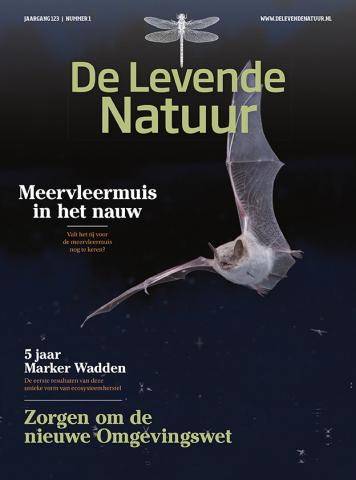De Levende Natuur nummer 1 van 2022 (English summary)
Afbeelding

A new form of ecosystem recovery through Marker Wadden
Lake Markermeer in the Netherlands is an example of a degrading aquatic ecosystem that cannot be restored to its original characteristics for socio-economic reasons, including water safety. The lake was created by closing off an estuary to protect it against floods, and therefore lacks elements that characterize natural lakes. The last decades the ecological quality of Lake Markermeer diminished, leading to the initiation of a nature-based solution in 2016: the construction of a five-island archipelago, “Marker Wadden”, from the lake’s soft sediments. The Marker Wadden-project used an engineering approach to add missing natural elements to the lake: gradual land-water transitions, heterogeneity in water depths, and shelter against windswept waves and sediment resuspension. This stimulated the food web bottom-up by improving primary production and trophic transfer of this productivity to higher trophic levels. This project illustrates how forward- looking development of lake ecosystems using a rewilding approach can be achieved while maintaining existing ecosystem services.
House insulations threaten pond bats
The pond bat is a Palaearctic (between latitude 49-61) insectivorous bat. It occurs mainly in lowland areas in cool and humid climates, often in open landscapes with abundant large, calm water surfaces. Over its entire range, the pond bat is considered a rare habitat specialist, with a decreasing population trend, hence the listing by the IUCN as ‘near threatened.’ Buildings used as roost play a central role in the life history of the pond bat. Pond bats are sometimes not welcome in residential buildings and forced to move. Because of its preference to outdated houses, the pond bat faces additional problems, as their houses are insulated, renovated, or demolished. Relocation to other roosts leads to a downward spiral of causes and consequences, often starting with less optimal thermal conditions in the new roost, leading to a decrease in thermoregulatory efficiency, culminating in decrease of both the size of the breeding colony and the size of the population.
Effects of the Frisian meadow bird policy 2014-2020
In this article I present trends in numbers and reproduction of meadow birds in the province of Friesland over 2008-2020, as part of the evaluation of the conservation policy of the province over 2014-2020. Conservation policy was especially aimed at customized area management for meadow birds. Two out of eight species have a more positive population trend in Friesland than the national trend. The other six have provincially similar trends as nationally, of which four are negative (black-tailed godwit, European lapwing, oystercatcher, redshank). A cause of bad performance of black-tailed godwit and European lapwing likely is insufficient reproduction. Five out of eight species have better (or less negative) population trends in managed areas than on regular farmland without protection. In that sense, conservation policy was successful. Surprisingly, skylark, meadow pipit and yellow wagtail show a positive provincial trend, because of good performance in managed areas. The new provincial conservation policy 2021- 2030 has high ambitions and is ecologically sound, but whether it succeeds, is doubtful.
Badgers and earthworms
Earthworms are an essential constituent of the daily menu of badgers. The availability of earthworms therefore deserves ample attention in decision making on the conservation and rehabilitation of badger habitat. First of all, this requires badger-friendly and earthworm-friendly management of grassland: no deep drainage, no ploughing-down of grassland, regular manuring preferably with solid manures, grazing rather than cutting regimes, liming and irrigation when needed, and the use of light-weight machinery for manuring and harvesting. Nature development should refrain from moving earth whenever this would destroy existing grassland. If inevitable, however, grassland should be re-established. To assure that this grassland will soon contain earthworms again, inoculation with cultured earthworms may be an option, be it under conditions.

